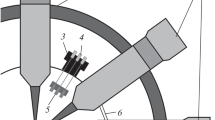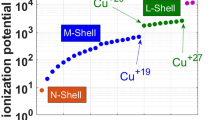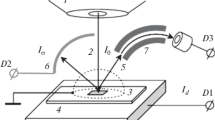Abstract
This article is a survey of works by the author and colleagues on the investigation of charging and discharging dynamics in solid dielectrics exposed to dense electron beams with subnanosecond resolution. Small high-current electron accelerators of theDzhin type, which were developed and fabricated at the Nonlinear Physics Laboratory, were used as the source of the primary electron beam. The primary electron beam parameters were: 0.25–0.45 MeV, 1–30 nsec, 0.1–10,000 A/cm3. The dielectric is investigated experimentally with its surface covered by a metallic electrode and with critical electron emission into the vacuum eliminated. In this case, the total current in the dielectric consists of three components: the primary beam current, the displacement current, and the conduction current. The first and last are responsible for charging and discharging of the dielectric volume. It is shown that the bulk nonequilibrium radiation conduction mechanism depends greatly on the dose intensity. For small dose intensities, the principal current carriers are the low-energy electrons of the conduction band and holes of the valence band, which are in quasi-equilibrium with the lattice phonon field before capture by defects or merging into excitons preceding recombination. This type of conduction has been well studied in the physics of semiconductors and dielectrics. However, over a broad interval of intermediate and high dose intensities, another type of nonequilibrium conduction dominates — the high-energy, which was discovered and studied by the author and colleagues. The principal carriers are then passive-ionization electrons and holes with energies of 0.1–10 eV in the process of phonon relaxation in which phonon emission dominates absorption. The high-energy conduction differs considerably from the low-energy in many properties, which determines the unusual dynamics of dielectric charging and discharging with irradiation by the dense electron beam of a high-current accelerator.
Similar content being viewed by others
References
Y. Kondo, M. Hirai, and M. Ueta, J. Phys. Soc. Jpn.,33, No. 1, 151 (1972).
D. I. Vaisburd and I. N. Balychev, Pis'ma Zh. Éksp. Teor. Fiz.,15, No. 9, 537 (1972).
A. G. Vaisburd and D. I. Vaisburd, Intern. J. Rad. Appl. Instr., Pt. D: Nuclear Tracks and Radiation Measurements,20, No. 2, 315 (1992).
D. I. Vaisburd and É. G. Tavanov, Pis'ma Zh. Tekh. Fiz.,1, No. 11, 531 (1975).
D. I. Vaisburd and B. N. Semin, Pis'ma Zh. Éksp. Teor. Fiz.,92, 197 (1980).
D. I. Vaisburd and B. N. Semin, Proceedings, IX International Conference “BEAMS'92”, May 25–29, Vol. 2, Washington, DC (1982), p. 1360.
D. I. Vaisburd and S. B. Matlis, Proceedings, VII International Conference of High-Power Particle Beams, Vol. 2, Karlsruhe, FRG (1988), p. 1067.
D. I. Vaisburd, S. U. Gol'denberg, V. P. Karateev, and O. D. Khlebnikov, Dokl. Akad. Nauk SSSR,314, No. 2, 364 (1990).
I. N. Balychev, D. I. Vaisburd, and G. I. Gering, Izv. Vyssh. Uchebn. Zaved. Fiz., No. 157 (1975); Pis'ma Zh. Tekh. Fiz.,2, No. 7, 327 (1976).
D. I. Vaisburd, S. I. Tverdokhlebov, and A. M. Kotlyarevskii, Proceedings, XIV International Symposium on Discharges and Electrical Insulation in Vacuum, Santa Fe, New Mexico (1990), p. 395.
A. L. Bardenshtein, V. I. Bykov, and D. I. Vaisburd, Pis'ma Zh. Éksp. Teor. Fiz.,61, No. 2, 96 (1995).
D. I. Vaisburd, B. N. Semin, É. G. Tavanov, et al., High-Energy Electronics of Solids [in Russian], Nauka, Novosibirsk (1982).
V. V. Butkov and D. I. Vaisburd, Dokl. Akad. Nauk SSSR,293, No. 3, 598 (1987).
D. I. Vaisburd, B. N. Semin, E. S. Serobyan, and V. A. Trofimov, Prib. Tekh. Éksp.,6, 135 (1986).
B. P. Aduev, D. I. Vaisburd, A. A. Kondrashov, and P. A. Pal'yanov, Prib. Tekh. Éksp., No. 3, 155 (1991).
D. I. Vaisburd, Proceedings, International Conference 1979, Radiation Physics of Semiconductors and Related Materials, Univ. Press, Tbilisi (1980), p. 198.
Additional information
Institute of High-Current Electronics, Siberian Section, Russian Academy of Sciences. Tomsk Polytechnic University. Translated from Izvestiya Vysshikh Uchebnykh Zavedenii, Fizika, No. 11, pp. 109–119, November, 1996.
Rights and permissions
About this article
Cite this article
Vaisburd, D.I. High-energy passive-ionization electrons and holes in dielectrics with pulsed irradiation by high-density electron beams. Russ Phys J 39, 1093–1101 (1996). https://doi.org/10.1007/BF02436152
Issue Date:
DOI: https://doi.org/10.1007/BF02436152




